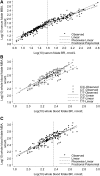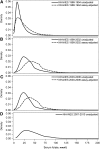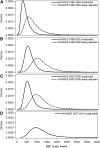Changes in measurement procedure from a radioassay to a microbiologic assay necessitate adjustment of serum and RBC folate concentrations in the U.S. population from the NHANES 1988-2010
- PMID: 22437557
- PMCID: PMC3327748
- DOI: 10.3945/jn.111.156901
Changes in measurement procedure from a radioassay to a microbiologic assay necessitate adjustment of serum and RBC folate concentrations in the U.S. population from the NHANES 1988-2010
Abstract
The NHANES measured serum and RBC folate concentrations by using a radioassay during prefortification (1988-1994) and postfortification (1999-2006) periods followed by the use of a microbiologic assay (MBA) from 2007-2010. The MBA produces higher concentrations than does the radioassay and is considered to be more accurate. To allow for accurate long-term trending (1988-2010), we evaluated different regression models (linear, piecewise linear, and fractional polynomial) to assay-adjust the radioassay results to be comparable to the MBA results. The data used to derive the regression models originated from 2 crossover studies in which the 2 assays were applied to a set of 325 serum and 171 whole-blood samples. Fractional polynomial regression of logarithmically transformed data provided the best fit for serum folate. Linear regression of logarithmically transformed whole-blood data provided an equally good fit compared with the other models and was the simplest to apply for RBC folate. Prefortification serum and RBC folate geometric mean concentrations increased after adjustment from 13.0 to 16.7 nmol/L and from 403 to 747 nmol/L, respectively. Postfortification serum folate concentrations increased from ~30 to ~43 nmol/L, and RBC folate concentrations increased from ~600 to ~1100 nmol/L after adjustment, with some variation across survey cycles. The presented regression equations allow the estimation of more accurate prevalence estimates and long-term trends in blood folate concentrations in the U.S. population by using results that are equivalent to the MBA. This information will be useful to public health officials in the United States who are dealing with folic acid fortification issues.
Conflict of interest statement
Author disclosures: C. M. Pfeiffer, J. P. Hughes, R. A. Durazo-Arvizu, D. A. Lacher, C. T. Sempos, M. Zhang, E. A. Yetley, and C. L. Johnson, no conflicts of interest.
Figures



References
-
- Raiten DJ, Fisher KD. Assessment of folate methodology used in the third National Health and Nutrition Examination Survey (NHANES III, 1988–1994). J Nutr. 1995;125:1371S–98S - PubMed
-
- Fazili Z, Pfeiffer CM, Zhang M. Comparison of serum folate species analyzed by LC-MS/MS with total folate measured by microbiologic assay and BioRad radioassay. Clin Chem. 2007;53:781–4 - PubMed
-
- Fazili Z, Pfeiffer CM, Zhang M, Jain RB, Koontz D. Influence of 5,10-methylene-tetrahydrofolate reductase polymorphism on whole blood folate concentrations measured by LC-MS/MS, microbiologic assay and BioRad radioassay. Clin Chem. 2008;54:197–201 - PubMed

